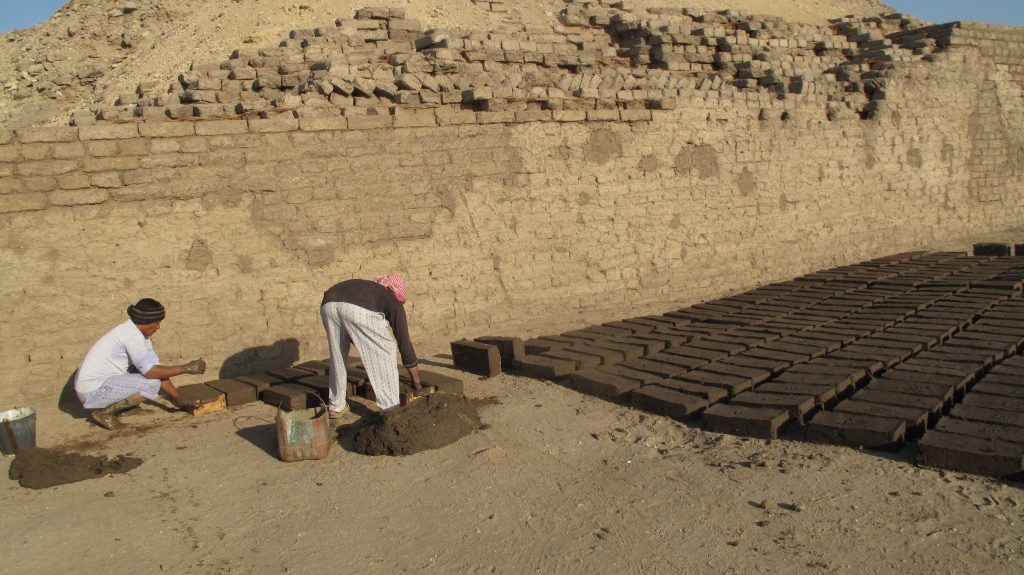
Deir el-Ballas is probably one of the most important sites in Egyptian History and also one of the least well known, Deir el- Ballas was the forward capitol of the Theban kings during their drive to expel the Hyksos invaders in the north and reunite the land founding the glorious New Kingdom three thousand, five hundred years ago. Founded by king Seqenenre Tao around 1550 B. C. Deir el-Ballas seems to have set the pattern for these royal cities of the New Kingdom like Malqata and Tell el Amarna.
At the center of the site is a monumental structure known as the North Palace that must have served as the campaign palace for the Kings Seqenenre, Kamose, and Ahmose. Like the later royal cities, there was a series of houses, including large villas for the royal court, a workmen’s settlement with associated cult chapels, storage magazines, and cemeteries. At the southern end of the site is a massive watchtower, mistakenly identified as the “South Palace,” which was a watchtower built around the top of a hill that gave a commanding view of the Nile and the territory around. It would seem to be from here that the Theban fleet was marshaled and sailed north to victory. After the Hyksos expulsion, the site was no longer needed and Deir el-Ballas was abandoned, but later a Coptic Church was built over the ruins of the North Palace. Both the ‘South Palace’ and the North Palace were partially built on casemate foundations, rectangular
chambers of mud-brick filled in with sand and stone rubble.
The site was first excavated by George Andrew Reisner working for the Hearst Expedition of the University of California, Berkeley in the years 1900-1901, but never published and was long forgotten. In the 1980s Peter Lacovara came across the records of the site in Reisner’s archives in the Boston Museum of Fine Arts and he worked several seasons at the site between 1980 and 1986 with Rabbia Hamdan of the Qena Inspectorate.
Several years ago when Mustafa Waziri was Chief Inspector at Qena, he asked Peter Lacovara to come back to the site because it was in danger of destruction by the expansion of the neighboring modern village. Working with Salima Ikram of the American University in Cairo, Peter Lacovara and the Ancient Egyptian Heritage and Archeology Fund hopes to protect and preserve the ancient monuments at Deir el-Ballas, so that people in the future can appreciate this important place in Egyptian history and would like to thank Dr. Ayman Hindi and the Inspectorate of Qena for all their help and support.
دير البلاص :
يعتبر دير البلاص واحد من أهم المواقع في التاريخ المصري وأيضًا المواقع الأقل شهرة، وكان دير البلاص هو العاصمة البديلة لملوك طيبة خلال حملتهم لطرد الهكسوس في الشمال وإعادة توحيد البلاد والتي أسست بداية المملكة الحديثة المجيدة منذ ثلاثة آلاف وخمسمائة عام. أسس دير البلاص الملك سقنن رع، و يبدو ان تأسيسها قد حدد نمط هذه المدن الملكية في المملكة الحديثة مثل الملقطة وتل العمارنة.
يوجد في وسط الموقع بناء ضخم يُعرف باسم “القصر الشمالي” والذي بالتأكيد وظف بمثابة قصر الحملة العسكرية للملوك سقنن رع و كامس و احمس .
و مثل المدن الملكية التي بنيت بعد ذلك، كانت هناك سلسلة من المنازل ، بما في ذلك الفيلات كبيرة للديوان الملكي ،و مستوطنة للعمال متصلة بها مصليات الدينية ، ومستودعات التخزين ومقابر.
في الطرف الجنوبي من الموقع ، يوجد برج مراقبة ضخم ، يُعرف خطأً باسم “القصر الجنوبي” ، والذي كان برج مراقبة مبنيًا حول قمة تل يوفر منظرًا قياديًا للنيل والمنطقة المحيطة به. و علي ما يظن انه من هنا أن الأسطول الطيبي تم تنظيمه وأبحر شمالًا حتى النصر.
بعد طرد الهكسوس ، لم تعد هناك حاجة إلى الموقع وتم التخلي عن دير البلاص ، ولكن قد تم بناء كنيسة قبطية في وقت لاحق على أنقاض القصر الشمالي. تم بناء كل من “القصر الجنوبي” والقصر الشمالي مبني جزئيا علي غرف مستطيلة من الطوب الطيني مملوءة بالرمال والحجارة.
تم التنقيب عن الموقع لأول مرة على يد جورج أندرو ريزنر الذي كان يعمل في بعثة هيرست بجامعة كاليفورنيا في بيركلي في الأعوام 1900-1901 ، لكنه لم ينشر بحثه و تم نسيه . في ثمانينيات القرن العشرين ، صادف بيتر لاكوفارا سجلات الموقع في أرشيفات ريزنر في متحف بوسطن للفنون الجميلة ، وعمل عدة مواسم في الموقع بين عامي 1980 و 1986 مع ربيعة حمدان من مفتشي قنا.
منذ عدة سنوات عندما كان مصطفى وزيري كبير المفتشين في قنا ، طلب من بيتر لاكوفارا العودة إلى الموقع لأنه كان في خطر التدمير من خلال توسيع القرية الحديثة المجاورة. من خلال العمل مع سليمة إكرام من الجامعة الأمريكية في القاهرة ، يأمل بيتر لاكوفارا وصندوق تراث الآثار المصرية القديمة في حماية الآثار القديمة في دير البلاص والحفاظ عليها ، حتى يتمكن الناس في المستقبل من تقدير هذا المكان المهم في التاريخ المصري و أود أن أشكر الدكتور أيمن هندي ومفتشية قنا على كل مساعدتهم ودعمهم.
